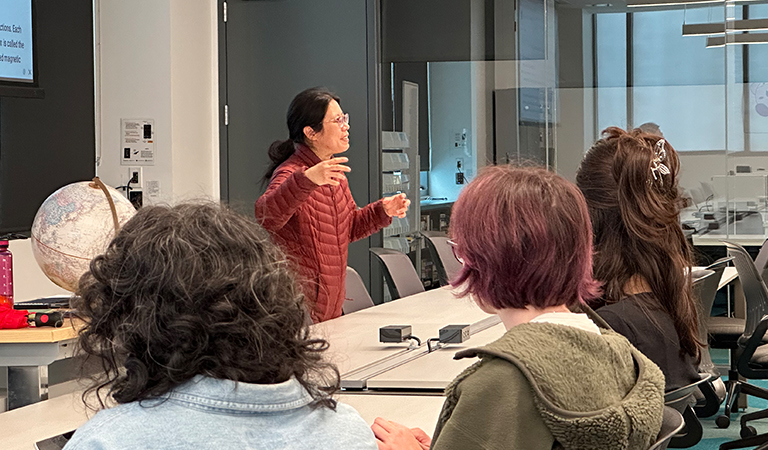NSF Supports Computational Chemistry
January 24, 2024
Harvey Mudd College chemistry professor Bilin Zhuang says her goal in teaching is to make physical and computational chemistry fun and accessible for students from various backgrounds. A recent National Science Foundation CAREER grant will support her efforts via her project “Developing a Hybrid Adaptive Particle-Field Simulation Method for Solvation of Charged Macromolecules and a New Computational-Chemistry Course for Lower-Division Undergraduates.”
The grant will support Zhuang’s research group to develop an improved method to perform all-atom simulations for large molecules in solutions. All-atom simulation is a convenient tool for studying interactions between molecules, but it is very costly for systems of large molecules in solution, which are ubiquitous in nature (DNA molecules in our bodies, for example). To enable these simulations, Zhuang and her research group will develop a simulation method that can drastically reduce the number of solvent molecules considered with molecular details while capturing the dynamics of the solution environment. This method will provide a convenient and accelerated tool for simulating large molecules in solution and will require fewer computational resources. “We hope this method will make molecular simulation more widely accessible for students in chemistry, with the fewer computational resources required” Zhuang says.
Zhuang will also develop a computational chemistry course (CHEM 60) for lower-division undergraduate students, using computation to aid and excite students’ learning in chemistry. The new computational chemistry course will introduce ideas in quantum calculations, molecular modeling, cheminformatics and chemical data at the level accessible to beginning chemistry majors and non-majors, equipping students with computational chemistry knowledge that can be used in a wide range of STEM disciplines and careers. “We introduce computational chemistry tools to first-year students, before some of them have learned about electron orbitals” she says. The course provides an accessible way for students to use computational tools to learn chemistry concepts through active discovery. “The codes run on Google Colab, which can be readily used without the need for much infrastructure and software. In doing so, we hope to make chemistry more visual and intuitive for students beginning in chemistry.”
In CHEM 60, through the use of Jupyter notebooks on Google Colab, students will be participating in the course development by generating new codes and data as course materials. These can be use by the wider chemistry teaching communities in high schools and colleges. The course projects in CHEM 60 also involve Department of Chemistry research projects, in which the students will also participate.
Zhuang’s group at Harvey Mudd uses and develops a range of theoretical and simulation tools to study how molecules in a liquid organize themselves. “For example,” she says, “we try to understand why water is so ‘weird’—while most materials expand on heating, water becomes denser when you heat it between 0 to 4 degrees Celsius!”
They also study how molecules interact in water and other solvents and how molecules in a liquid organize themselves despite the messiness of a liquid environment. “Our group typically involves students from a wide range of disciplines and backgrounds so that we can look at the questions from different perspectives,” Zhuang says. “In past years, my group has hosted chemists and biologists investigating how large molecules like proteins and polyelectrolytes interact in a solution, physicists developing statistical measures to characterize molecular structures and thermodynamics theories for describing the molecular organization in liquids, computer scientists developing machine-learning algorithms to decipher the order in the liquid’s messy molecular organization and code useful Python modules for computational chemistry and many more—my group has even hosted historians and economists.”
The project plans to support 15 students in the project over five years. NSF grants are the largest share of external support for faculty research at Harvey Mudd.
“I am excited about the opportunity to work on the research project with undergraduate students, who often offer fresh perspectives and ideas” Zhuang says. “I am also particularly excited about teaching Computation in Chemistry to first-year students with chemistry professor Sarah Kavassalis. Usually, the course is taught at upper-level undergraduate and graduate levels with lots of technical materials, but we think computation has a lot to offer for beginning chemistry students.”
